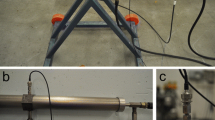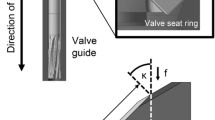On the basis of an experimental and theoretical approach, the authors have considered an algorithm for modeling the behavior of advanced propellants in barreled systems of varying caliber. The proposed algorithm makes it possible to conduct preliminary investigations into the possibility of using advanced fast-burning propellants in the existing barreled systems and in advanced systems of varying calibers and for various purposes. A possible increment in the muzzle velocity of a projectile due to the advanced propellants added to the propellant powder charge is assessed without full-scale testing.
Similar content being viewed by others
References
A. W. Horst, A Brief Journey through the History of Gun Propulsion, ARL-TR-3671, November 2005.
R. S. Damse and A. Singh, Advanced concepts of the propulsion system for the futuristic gun ammunition, Defence Sci. J., 53, No. 4, 341–350 (2003).
R. E. Tompkins, K. J. White, W. F. Oberle, and A. A. Juhasz, Traveling Charge Gun Firings Using Very High Burning Rate Propellants, Technical Report — ADA203307, Army ballistic research lab Aberdeen proving ground, MD (1988).
W. F. Oberle, G. P. Wren, F. W. Robbins, K. J. White, and R. E. Tompkins, Parameters for Optimizing a Traveling Charge Gun System, Technical Report — A666591, Army ballistic research lab Aberdeen proving ground, MD (1988).
P. G. Baer, A Parametric Study of a 40-mm Air Defense Gun Using Conventional and Traveling Charge Propellant, Technical Report — A230891, Army ballistic research lab Aberdeen proving ground, MD (1988).
I. C. Stobie, J. D. Knapton, B. D. Bensinger, and R. A. Pate, Test Results Form a Two-Stage Traveling Charge Liquid Propellant Gun, Final Technical Report − ADA224593, Army ballistic research lab Aberdeen proving ground, MD (1990).
E. Ashley, Liquid propellant traveling charge gun concept, Technical Report − ADA033971, General Electric Co., Burlington, VT (1976).
M. Dervaux and M. Nicolas, Traveling charge gun theory, Interior Ballistics of Guns. AGARD Conference Proceedings, No. 392, Paper 22 (1985).
A. I. Safronov, Raising launching rates of elements to study the behavior of materials under pulsed actions, Vestn. Samarsk. Gos. Tekh. Univ., Ser. Fiz. Mat. Nauki, No. 27, 169–172 (2004).
A. I. Safronov and A. Yu. Krainov, Interior ballistics of a barrelled system with a joined drive-on chamber, Vestn. TGPU, Ser. Estestv. Tekh. Nauki, 6, No. 43, 67–70 (2004).
L. V. Larionov, G. I. Syrenkov, and D. V. Shchetinin, Optimizing the parameters of a traveling charge gun system, Fiz. Goreniya Vzryva, 30, No. 2, 117–119 (1994).
V. A. Burakov, V. V. Burkin, A. S. D’yachkovskii, et al., Experience gained in using plastoisol propellants in a travelingcharge regime, Abstracts of Papers Int. Youth Sci. Conf. "Topical Problems of Modern Continuum Mechanics and Celestrial Mechanics," November 17–19, 2011, Tomsk, pp. 139–140.
K. Ikuta, Two stage travelling charge accelerator for high velocity, Sci. Technol. Energy, 65, No. 1, 25–27 (2004).
Xin Lu, Yanhuang Zhou, and Yonggang Yu, Experimental and numerical investigations on traveling charge gun using liquid fuels, J. Appl. Mech., 78, Issue 5, Article 051002 (2011).
V. A. Burakov, V. V. Burkin, A. N. Ishchenko, et al., Experimental Ballistic Complex, RF Patent 2591132, F41F 1/(00) (2006.01). Published 13.04.2015. Bull. No. 19.
V. V. Burkin, A. S. D’yachkovskii, A. N. Ishchenko, et al., Information and measuring system of the Research Institute of Applied Mathematics and Mechanics of Tomsk State University, in: Collected Papers of Int. Youth Sci. Conf. "Topical Problems of Modern Continuum Mechanics and Celestrial Mechanics," November 17–19, 2014, TGU, Tomsk (2014), pp. 127–128.
Meter of Velocity in a DDS 6000 Barrel: a Passport [in Russian], Tais, Moscow (2010).
V. V. Burkin, A. S. D’yachkovskii, A. L. Egorov, et al., Muzzle-Velocity Sensor, RF Utility Model Patent 161396, G01P 3/42 (2006.01), G01P 3/66 (2006.01). Published 20.04.2016. Bull. No. 11.
Yu. P. Khomenko, A. N. Ishchenko, and V. Z. Kasimov, Mathematical Modeling of Intraballistic Processes in Barreled Systems [in Russian], Izd. SO RAN, Novosibirsk (1999).
A. N. Ishchenko and V. Z. Kasimov, Mathematical Model and a Software Package for Theoretical Investigation of Intraballistic Processes in Barreled Systems: a Manual [in Russian], Izd. Dom Tomsk. Gos. Univ., Tomsk (2015).
Yu. P. Khomenko, A. N. Ishchenko, V. Z. Kasimov, et al., Indentifying Laws of Burning and Gas Generation of Propellant Powder Charges on the Basis of Ballistic and Manometric Testing [in Russian], VNIIÉF, Sarov (2000).
M. E. Serebryakov, Interior Ballistics of Barreled Systems and Solid-Propellant Rockets [in Russian], Oborongiz, Moscow (1962).
Author information
Authors and Affiliations
Corresponding author
Additional information
Translated from Inzhenerno-Fizicheskii Zhurnal, Vol. 93, No. 3, pp. 661–668, May–June, 2020.
Rights and permissions
About this article
Cite this article
Ishchenko, A.N., Burkin, V.V., Kasimov, V.Z. et al. Analyzing the Use of Advanced Propellants in Artillery and Gun Systems from Experimental Data Obtained Under the Conditions of a Model Ballistic Installation. J Eng Phys Thermophy 93, 641–647 (2020). https://doi.org/10.1007/s10891-020-02162-z
Received:
Published:
Issue Date:
DOI: https://doi.org/10.1007/s10891-020-02162-z




